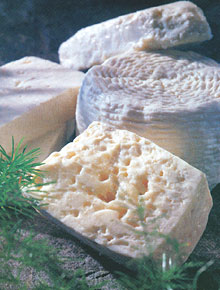Santorini Entertainment
Eating out:
restaurants & tavernas, local delicacies, traditional greek food, recipes, phone listing
Where to go & What to Do:
restaurants & tavernas, local delicacies, traditional greek food, recipes, phone/fax listing ...
Santorini Wines
the delicious wines of santorini, as well as wineries, grape varieties ...
Santorini Catering
santorini catering for weddings, conferences, private dinners, special events, picnics ...
Santorini Specialities :
Greek Tradition :
Feta Cheese Recipes :
Easter Recipes :
Christmas Recipes :
Santorini Restaurants & Tavernas
|
| Greek Feta Cheese : the Princess of Cheeses |
This white creation, a testament to the high standard of Greek cheese makers justifiably lays claim to the title 'princess'
of cheeses, and is coveted far above all other contenders.
Feta is the cheese consumed more than any other in Greece, taking
40% of the total quantity. If one bears in mind that on average the population eat 25 kilos, this means that the average Greek
consumes 10 kilos of feta per year. |
| We are talking about a cheese which has been produced for over 2 centuries in Greece, and older types have a connection
with the traditional 'touloumotiri' (a kind of cheese). Feta is a white skinless cheese, made in large square or triangle
slabs, and preserved in wooden barrels or tin containers filled with brine. In this way the freshness and acidity is maintained. |
It is made from sheep's milk or a combination of sheep and goat's milk. The goat's milk should not exceed a 30%
ratio. Pytia is used as well as cultivated sheep's yoghurt. After being salted, it rests a few hours at low temperatures,
and is later placed in barrels or containers filled with brine.
It is then refrigerated and is ready for consumption after 60
days. The hardness depends on the length of the ripening period and fats contained. A mature feta can be broken down like this:
Moistness: 52% Fats: 25-26% Proteins approx. :17% Salt: 1,8-2%
|
| to learn about Pytia click here |
| In spite of being patented in 1996 as a protected cheese name deriving from the country
of origin, Greece, other countries disputed the patent and legal proceedings continued right up till 2002. After
heated debates in court between Greece and other European countries, it became obvious that feta is an authentic
Greek cheese and is made only from sheep's milk. So, on the 14th October by order 1829/2002 feta became for the
2nd time Greek. Litigation however has not stopped there, and recourse has once again been sought by Denmark, Germany, France and Italy. |
| EU Court Ruling Protects Greek Feta |
| October 26, 2005 · The European Union's highest court has ruled that feta cheese is a traditional Greek product that deserves
protection throughout the 25-nation block. As a result, non-Greek European feta producers will not be allowed to call their product "feta."
After a 16-year legal battle, the European Court of Justice in a final ruling, announced that the definition of feta was reserved for cheese from Greece alone because
it had been registered as a protected "designation of origin" product by the European Commission in 2002.
The European Union's top court ended the country's acrimonious dispute with Denmark and Germany. There is no right of appeal against the October 25 decision.
The ruling was a landmark victory for the Greek rural landscape, where feta is believed to have been produced from a blend of sheep's and goat's milk for the past
6,000 years. Denmark and Germany wanted to use the same Greek name for feta-like cheese made in their countries.
Agriculture Minister Evangelos Bassiakos said "This is a historic vindication of Greek dairy farming and agriculture which is endowed with several products of
unique natural quality and ingredients through the millennia".
The decision was also welcomed by Greek dairy producers, who said the ruling would help market feta against rival products. "We can now relaunch our campaign to
promote the advantages of our products," said a statement by the Association of Greek Dairy Farmers and Manufacturers. |
|
| Variations of Feta from other areas in Greece |
| Small round basket-shaped, spicy & aromatic. Made from local sheep's milk on Limnos island. |
| 'Feta of the Fire' made in Messinia, salty, hard, spicy, ideal for making 'saganaki' or grilling. |
| Salty, dry, made from sheep's milk, or goat & sheep's milk, ideal for frying. |
|
|


